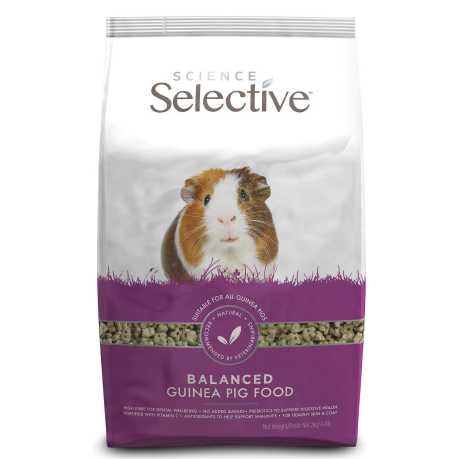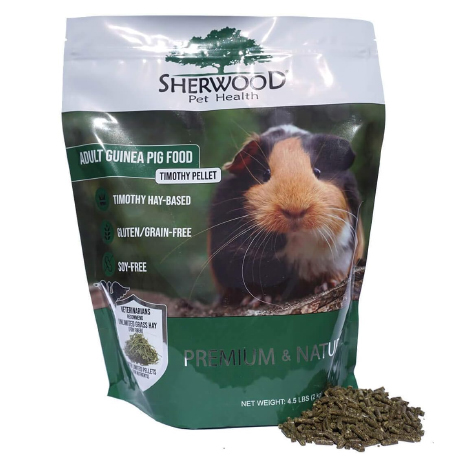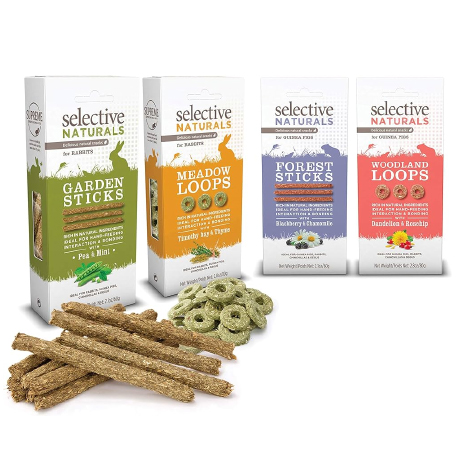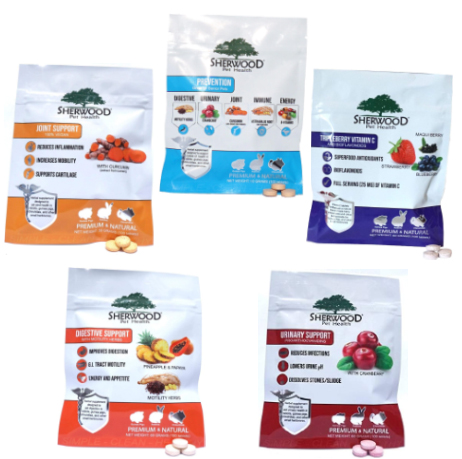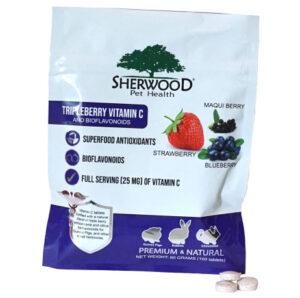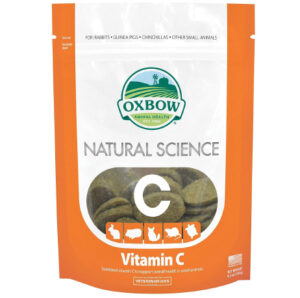GUINEA PIG CARE GUIDE
Guinea pigs, also known as cavies, originally come from the Andean region of South America. They were domesticated for food and companionship due to their gentle nature. In the 16th century, they were brought to Europe by Spanish explorers and quickly won the hearts of European nobility with their charming looks and sweet dispositions. Over the years, guinea pigs evolved from curiosities to beloved household pets, cherished worldwide for their friendly and affectionate personalities.
How Long Do Guinea Pigs Live?
Can You Have Just One Guinea Pig?
How Much Do Guinea Pigs Cost to Own?
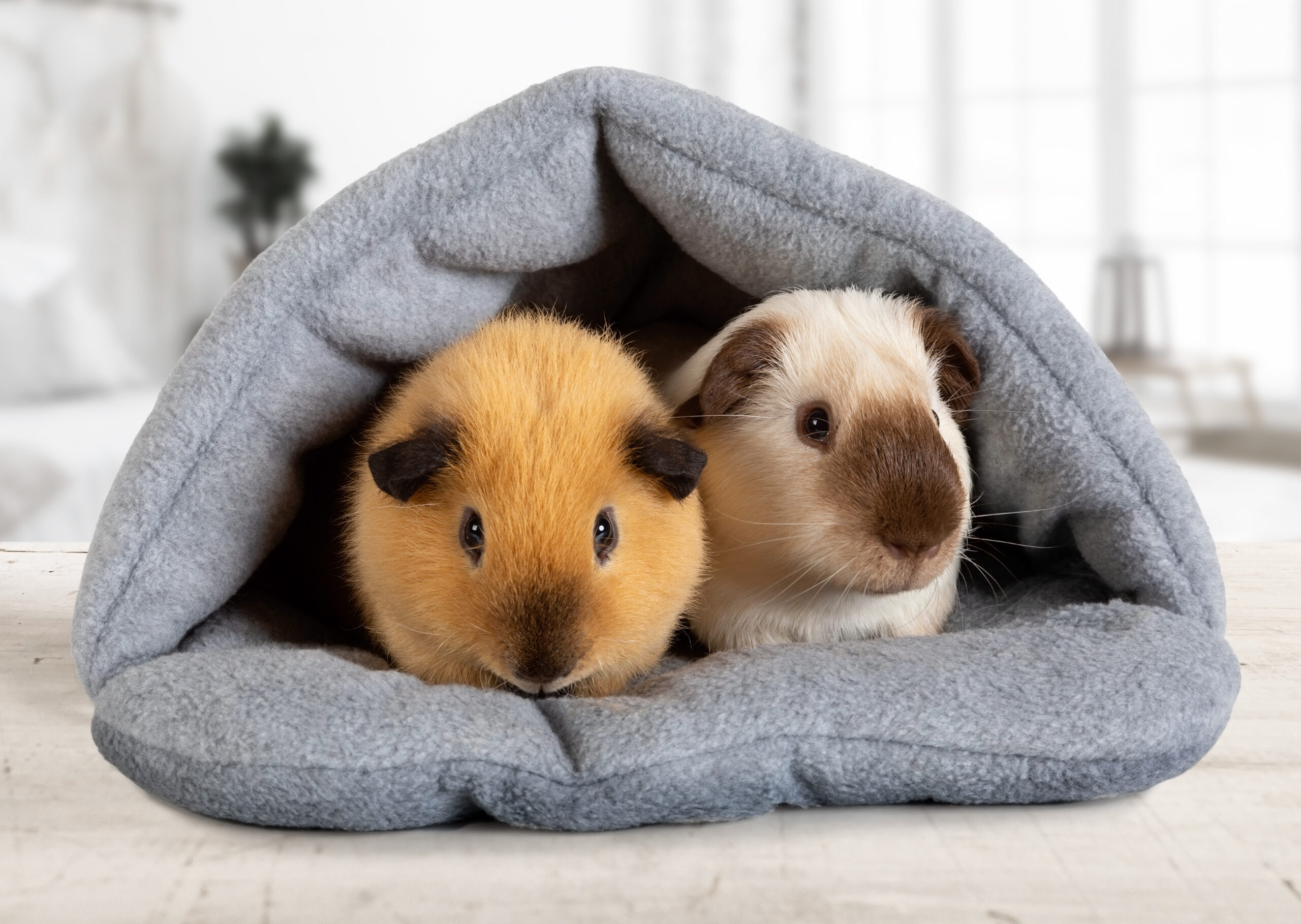
If you have decided to adopt or foster a guinea pig thank you & of course CONGRADULATIONS!
When properly socialized, guinea pigs are playful, curious and outgoing pets, making them ideal companions for both adults and children older than 12 years old. Guinea pigs are expressive and can communicate their moods through various sounds like purring, chirping, and squeaking. They tend to form strong bonds with their carers and provide a rewarding and interactive pet experience.
Whether you are a first-time guinea pig owner or are looking to deepen an existing bond, the following guide is for you. We’ll share insights into the best care practices used across multiple small animal rescues rescues and tips on feeding, housing, and handling guinea pigs.
Preparation
Before your new guinea pig, or guinea pigs, arrive you’ll need to make sure that you have all the essentials ready for their care and utmost comfort.
In addition to setting up their physical environment, sit down and write a daily and weekly care schedule that includes time for feeding, cleaning, and bonding. It’s important to overlap this care schedule with your existing work, school, social and familial commitments to ensure you can provide consistent and ongoing attention to your guinea pigs.
Project this schedule over the next 5-7 years to make sure you can dedicate the necessary time to develop a lifelong bond with your guinea pigs.
Establishing a Daily & Weekly Guinea Pig Care Routine
DAILY ROUTINE
Feeding:
- Morning (around 8-9 AM): Add a generous pile of fresh hay and 1 tbsp of guinea pig pellets.
- Evening (around 6-7 PM): Repeat the morning feeding routine and add 1/2-1 cup serving of fresh leafy greens and vegetables. Rinse and refill all water bottles.
PRO TIP: Use feeding times as an opportunity to bond. Hand feeding greens build trust and familiarity with your guinea pig. You can even train your guinea pigs to climb into your hand in exchange for a yummy leafy green or slice of bell pepper.
Habitat Maintenance:
- Morning and Evening (around feeding times): Remove uneaten hay and replace with fresh hay. Guinea pigs enjoy having a large pile of hay that they can burrow in.
- If you are using bedding in your guinea pigs enclosure, you will need to spot clean each day to remove waste and change out of all of the bedding every 3 or 4 days to maintain a clean and hygienic environment for you guinea pigs.
- If you use a guinea pig cage liner, fleece liner or bath mats, dedicate 15 minutes to tidying up your guinea pig’s enclosure each morning and evening. This includes sweeping or vacuuming loose hay and droppings to maintain a hygienic environment for your guinea pig. Liners will need to be changed out every 2 or 3 days so you will need at least 2 sets to use interchangeably.
SOMETHING TO THINK ABOUT: Do you have access to a reliable washing machine and drier to wash soiled guinea pig liners in?
WEEKLY ROUTINE
Deep Cleaning:
- Once a week you’ll need to do a deep cleaning. This means, removing all liners or bedding to wipe down the bottom of the enclosure with diluted vinegar or a safe cage cleaner. You can also use diluted vinegar and paper towels to wipe their hideys and litterbox, if you use one. Plastic hideys can also be rinsed in the sink. Examine toys and accessories for wear and tear and replace, as needed.
- If your enclosure has a canvas bottom like the “MidWest Guinea Pig Habitat” you can wash it in the washing machine once a month. Wash any soft hideys, cuddle cups or beds in the washing machine at least once a week.
- Wash their water bottles with warm, soapy water or in the dishwasher to maintain cleanliness and prevent bacterial growth.
Health Check:
- Assess your guinea pig’s health by checking their eyes, ears, teeth, bottoms of their feet, nails, fur and general body condition. Keeping a close eye on their physical condition helps in catching signs of illness early, ensuring timely medical attention.
PRO TIP: Get a pet scale and weight your guinea pigs each week. Keep a detailed log and talk to your veterinarian about any weight gain or loss. Most healthy guinea pigs weigh 800-1000g.
Essential Supplies for Guinea Pigs
How Much Space Do My Guinea Pigs Need?
For one or a female/female pair a minimum 2 x 4 enclosure like the “MidWest Guinea Pig Habitat” may be enough to start, a larger 2 x 5 enclosure or adding a loft is preferred. For a female/male pair or male/male pair a 2 x 5 enclosure is the minimum, a larger 2 x 6 enclosure or adding a loft is preferred. Cages and hutches do not provide enough room for adequate exercise and overall well-being.
Not providing enough space can lead to a host of problems, including depression and frustration for the guinea pigs, and undesirable behaviors like cage chewing, which can damage their teeth. Health issues such as obesity, heart disease, and infections are more common. It can also lead to fighting and bulling amongst the guinea pigs due to resource guarding.
For each additional guinea pig, add 2 to 4 square feet to their living space to maintain a healthy and harmonious environment.
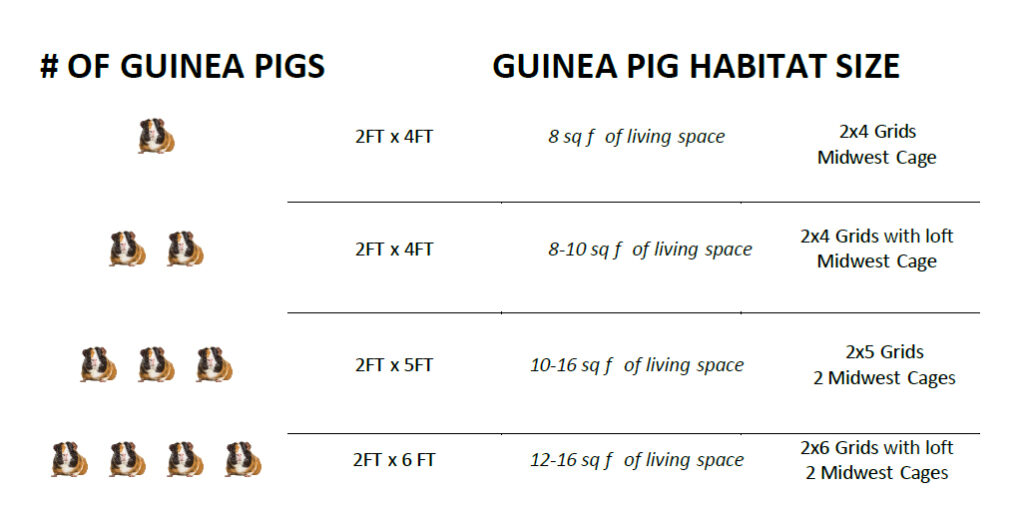
Housing
- For one or a female/female pair a minimum 2 x 4 enclosure like the “MidWest Guinea Pig Habitat” may be enough to start, a larger 2 x 5 enclosure or adding a loft is preferred. For a female/male pair or male/male pair a 2 x 5 enclosure is the minimum, a larger 2 x 6 enclosure or adding a loft is preferred. For each additional guinea pig add 2-4 sq ft to their living space to maintain a healthy and harmonious environment and prevent fighting and bullying due to resource guarding.
- You can get C&C grid cage in various sizes at “www.kavee.com“, “www.guineapigcagesstore.com“, and “Guinea Pig Cage Company“.
- You’ll need to decide if you’ll be using a fleece cage liner or bedding:
- For waterproof, fleece cage liner, we recommend “Guinea Pig Market“, “Guinea Dad“, “Kavee“, “Piggy Bedspreads” and “Etsy“.
- For soft bedding, we recommend “Oxbow Pure Comfort“, “Small Pet Select Unbleached White Paper Bedding“, “Small Pet Select Pelleted Paper Bedding“, or “Kaytee Clean & Cozy“.
- AVOID: clumping and clay cat litters and all soft wood shavings including pine, aspen and walnut. These can cause skin, eye and respiratory irritation.
- WATER BOTTLE get at least 1 water bottle per guinea pig to prevent resource guiding. Guinea pigs may hoard a single water source and keep other guinea pigs from drinking.
- HIDEY get at least 1 hidey house per guinea pig. For the same reason, you’ll want to provide 2 identical hidey houses to prevent one guinea pig from being left out or fighting over a more desirable house. Any tunnels, cuddle cups, cuddle sacks and hanging corners should also be provided in twos. Popular choices are: “Fleece Forest“, “Fleece Corner“, “Cuddle Sacks“, “Cuddle Cups“, “Guinea Pig Castle“, “Pigloo“, “Cardboard Hideaway” and “Woven Hideouts“
- CARRIER should be big enough for both guinea pigs, like this “Small Pet Carrier“.
- LITTERBOX or “Kitchen Area” to put their hay. You can use a “Mini Dustpan and Brush” to sweep up dropping and hay or a handheld vacuum.
- CHEW TOYS and lots of them! Check out “Oxbow” “Binky Bunny” and “Etsy“. Get a “Snuffle Mat“, “Puzzle Toy” and “Treat Ball” to promote foraging, stimulate their mind and encourage exercise.
- GROOMING SUPPLIES the amount of grooming your guinea pig will need and the type of supplies is going to depend on if they are short-haired or long-haired. See below.
- FOOD a balanced diet consists of mostly hay, vegetables and greens, fortified pellets. See below.
Grooming
Short Haired vs Long Haired Guinea Pigs
 There are also unique and hairless breeds like the Skinny, which requires special skin care similar to hairless cats and dogs, and the Texel, with its dense, fuzzy coat. Skinny pigs, which are mostly hairless except for some fur on their nose and feet, have difficulty regulating their body temperature. They should be kept out of direct sunlight, away from vents or fans, off of tile/marble/granite surfaces, and the temperature of their rooms closely monitored. Texels are bred for their natural long curly coats which are gorgeous but can be time consuming to maintain. They overheat easily and also need to be brushed daily and get their fur trimmed every 3-4 months.
There are also unique and hairless breeds like the Skinny, which requires special skin care similar to hairless cats and dogs, and the Texel, with its dense, fuzzy coat. Skinny pigs, which are mostly hairless except for some fur on their nose and feet, have difficulty regulating their body temperature. They should be kept out of direct sunlight, away from vents or fans, off of tile/marble/granite surfaces, and the temperature of their rooms closely monitored. Texels are bred for their natural long curly coats which are gorgeous but can be time consuming to maintain. They overheat easily and also need to be brushed daily and get their fur trimmed every 3-4 months.
BRUSHING
Short-haired guinea pigs need just occasional grooming with a soft brush once a week or so. Long-haired guinea pigs need daily brushing to prevent tangles, and keeps their coat healthy and free of debris.
We recommend: “Oxbow Enriched Life Wood Small Animal Brush & Comb“, “Small Pet Select Hair Buster Comb“, “Small Animal Grooming Kit“.
NAIL TRIMS
Trim, or file, your guinea pigs nails once a month. You will need a pair of small animal nail clippers and styptic powder to stop any accidental bleeding. Make sure to identify the quick (the pink part inside the nail) and trim just the tip, avoiding the quick to prevent bleeding. If you accidentally cut the quick, apply styptic powder to stop the bleeding.
We recommend: “Pet Nail Clippers” and “Kwik Stop Styptic Powder“.
PRO TIP: offer treats during and after nail trims and grooming sessions.
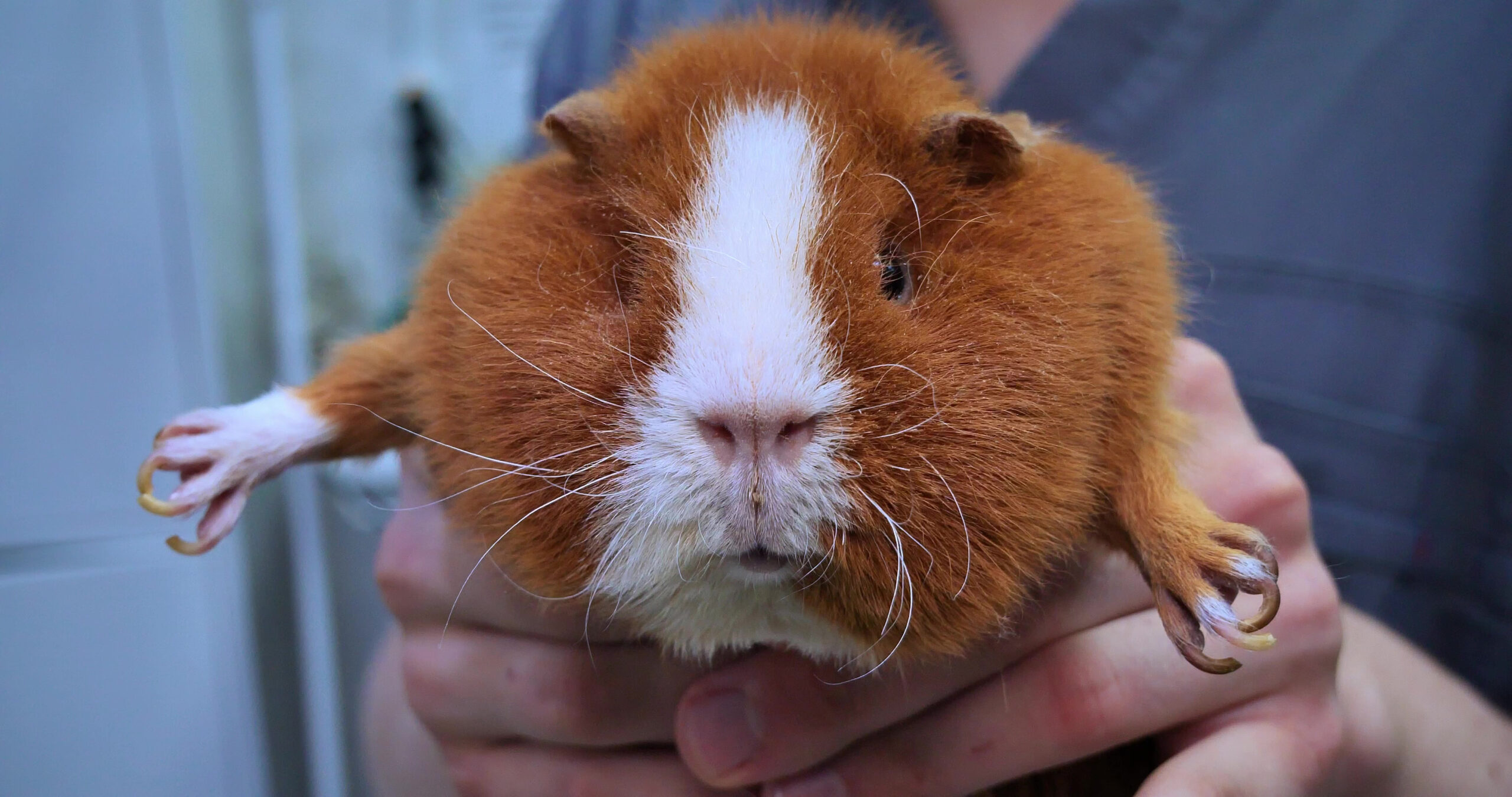
BATHING
Guinea pigs generally do not require frequent baths as they are self-cleaning animals. Bathing your guinea pig too often can lead to skin irritation and dryness, stripping their skin of natural oils. Over-bathing can also stress your guinea pig, potentially leading to health issues. Only bathe them when necessary and always use gentle products designed for small animals.
There are times when a bath is necessary, such as when their fur becomes soiled, they develop an odor, there is an infection or severe infestations of mites or lice.
Consult with a veterinarian if you you are unsure if your guinea pig needs a bath.
Guinea Pig Feeding Guide
Recommended Diet
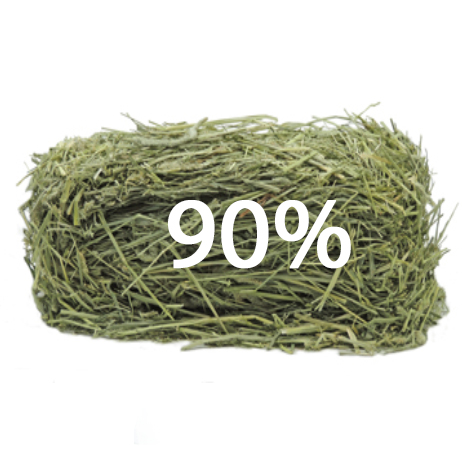
HAY
80-90% of a guinea pigs diet should be hay. Guinea pigs should have UNLIMITED access to fresh high-quality hay 24/7. Soiled hay should be changed out daily.
- Juvenile guinea pigs: Alfalfa Hay
- Adult guinea pigs: Timothy Hay
PRO TIP: “Oxbow” and “Small Pet Select” offer a variety of high quality hays (oat, botanical, orchard) if you would like to offer diverse flavors and textures in addition to western timothy hay.

LEAFY GREENS & VEGETABLES
10% of a guinea pigs diet should be green leafy vegetables. Organic vegetables (no pesticides) are recommended whenever possible. Always remove seeds as these are a choking risk.
- Juvenile guinea pigs: can start to have small amounts of vegetables introduced into their diet at 2 months old. Vegetables should be introduced gradually, one per week, so that you can monitor for sensitivity or stomach upset. If any vegetable seems to cause digestive problems do not feed it in the future.
- Adult guinea pigs: can have 1/2 cup (a small pinch) of leafy greens and 1 tablespoon of non-leafy green vegetables per day.
You can feed up to 1/2 cup of green leaf, red leaf and butter leaf lettuces daily. Other leafy greens like romaine, spinach, kale, turnip greens, dandelion greens, arugula, bok choy, and watercress and herbs like cilantro, basil, parsley, mint, and dill can be offered for variety 1-3 times per week.
You can also feed 1 tablespoon of the following non leafy vegetables: bell peppers, celery (remove veins or cut into small pieces), cucumber, green beans. Feed broccoli, cauliflower, cabbage, brussel sprouts and radishes only occasionally.
If your guinea pigs poops become small, dark, or smelly this amount should be reduced to every other day or 3 times per week. Read this: “Guide to Guinea Pig Poop“

FOOD PELLETS
5% of a guinea pigs diet should be fortified food pellets.
- Juvenile guinea pigs: 1 tablespoon of pellets per day.
- Adult guinea pigs: 2 tablespoons of pellets per day.

FRUITS & TREATS
Less than 5% of a guinea pigs diet can be fruits and treats. Guinea pigs shouldn’t get more than 1-2 teaspoon size servings of fruits per week. That’s about the size of 1 strawberry or 1 baby carrot PER WEEK.
Carrots, apple, berries (strawberries, blueberries, raspberries), orange, banana, pear, grapes (cut), kiwi, mango, papaya, peach, pineapple, apricot, tomatoes, watermelon, cantaloupe.
Always remove seeds and pits. Offer watery fruits like watermelon and cantaloupe sparingly as they can cause diarrhea.
We recommend: “Oxbow“, “Science Selective“, “Small Pet Select” or “Sherwood“.
Avoid: nuts, seeds, corn, grains, dairy, fillers, artificial colors and added sugars.
“Mix” pellets and treats with seed and corn can lead to chocking and malnutrition due to selective eating. The first ingredient listed for pellets should be timothy hay for adult guinea pig pellets or alfalfa hay for young guinea pigs.
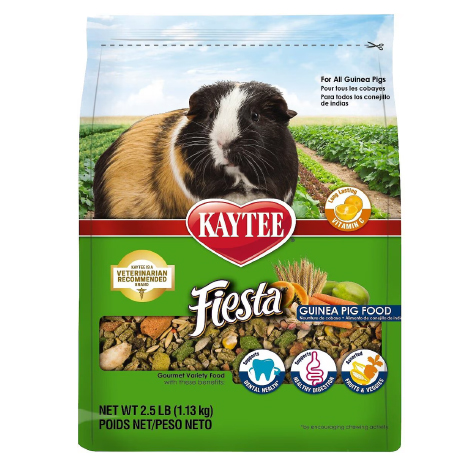



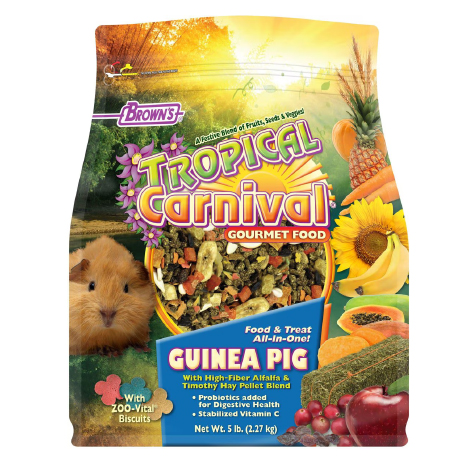
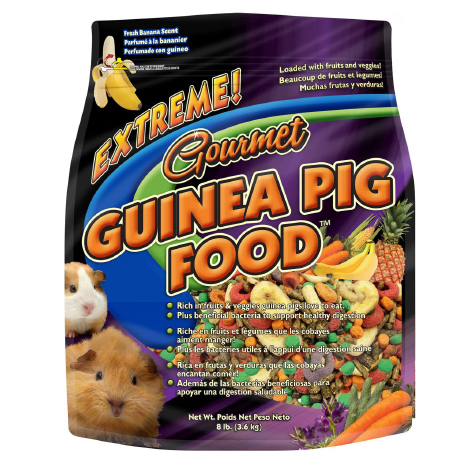
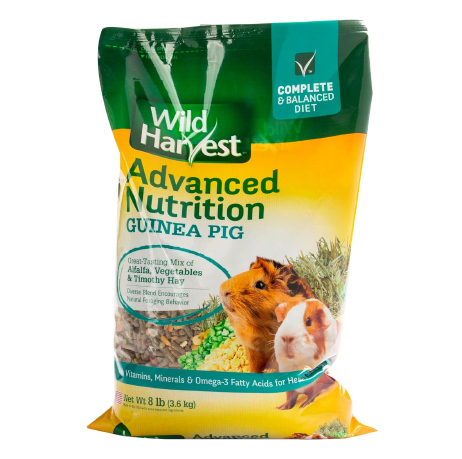
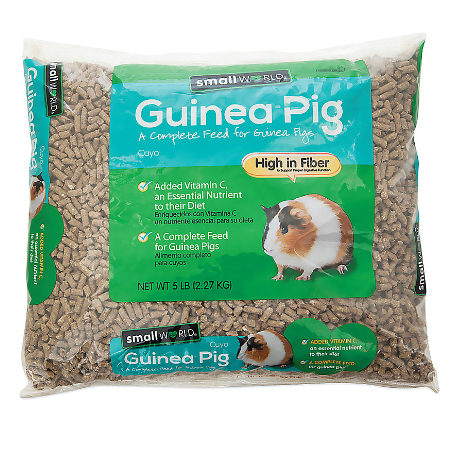

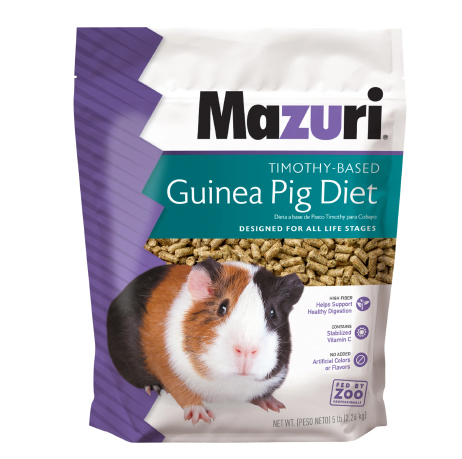
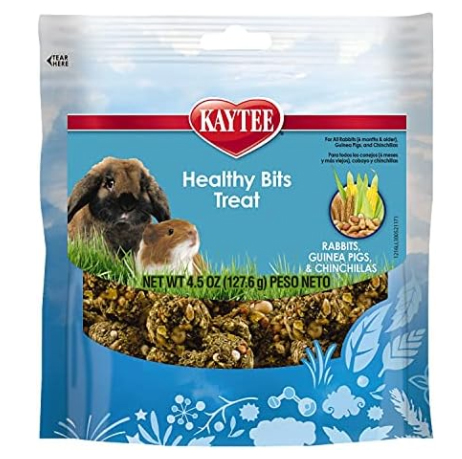
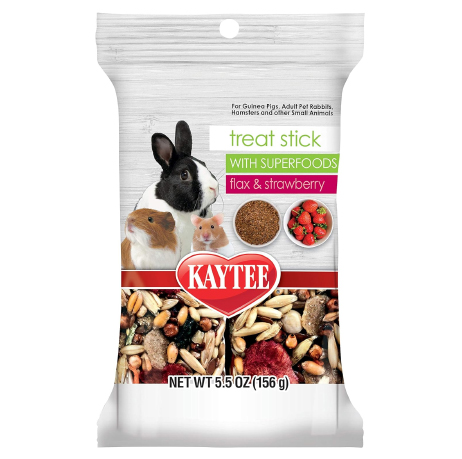
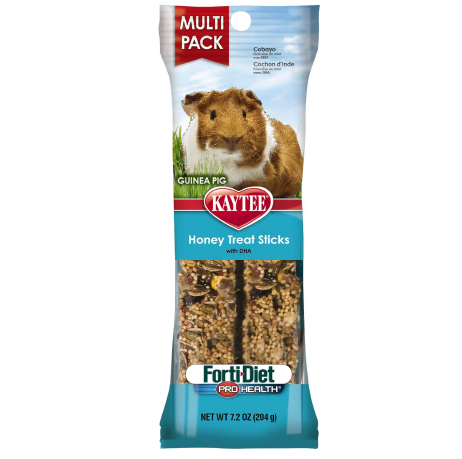
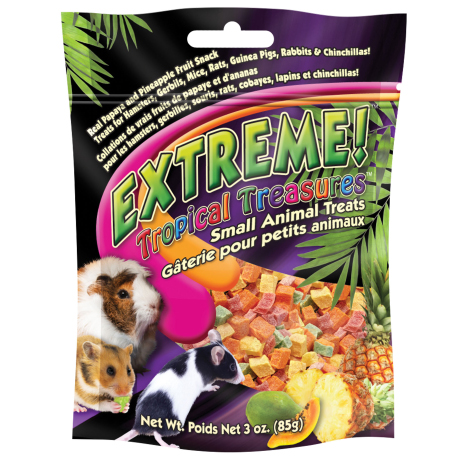

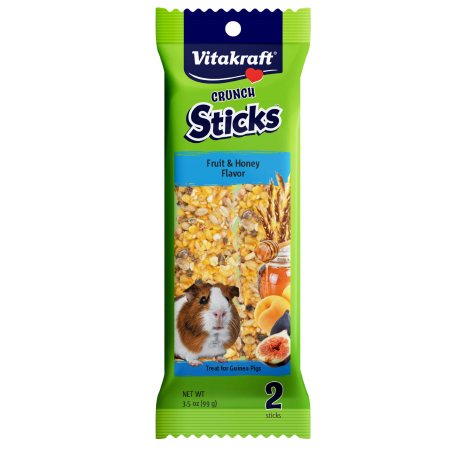
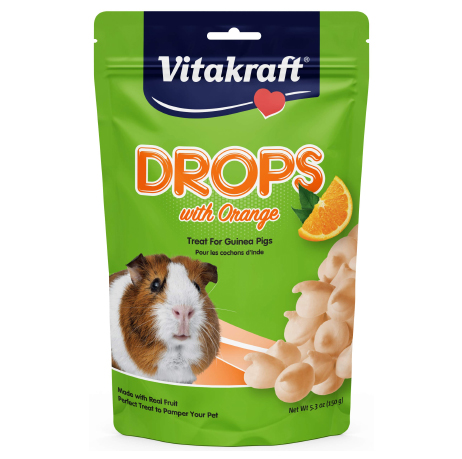
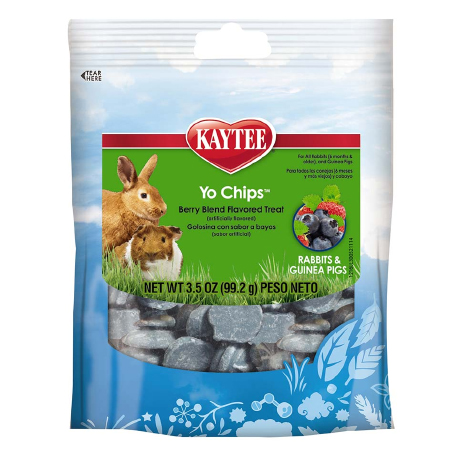
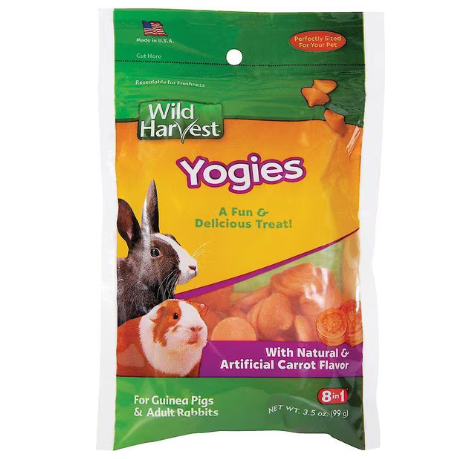
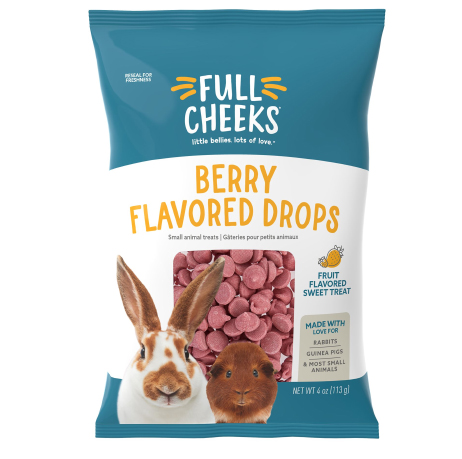


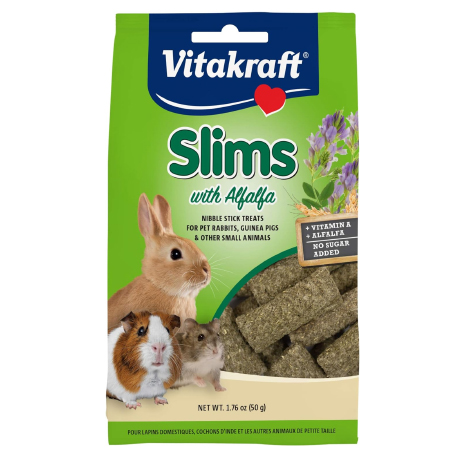
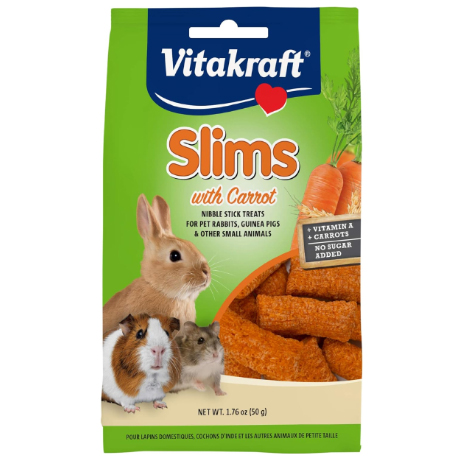
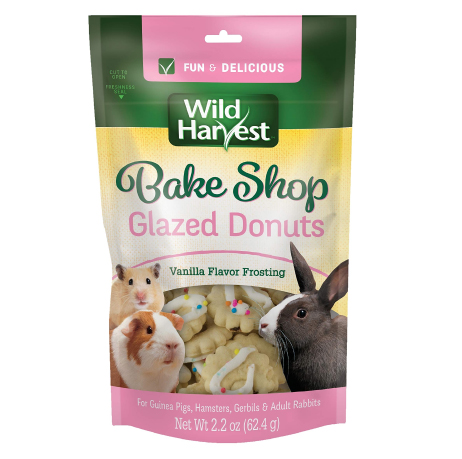

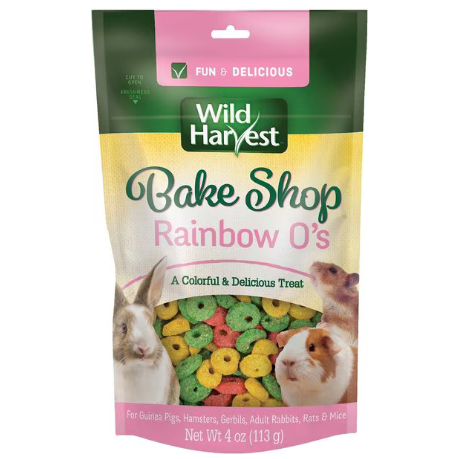
THIS IS NOT A COMPLETE LIST OF ALL AVAILABLE FOOD PELLETS AND TREATS BUT SHOULD HELP YOU TO HAVE A BETTER UNDERSTANDING ABOUT WHICH BRANDS AND INGREDIENTS MAY NOT BE SUITABLE FOR GUINEA PIGS.
Contact Us if you have a specific question about food pellets or treats.
What Happens if a Guinea Pig Doesn't Get Enough Vitamin C?
Scurvy is a painful and sometimes fatal disease that can occur to guinea pigs if they don’t get enough Vitamin C. Like humans, guinea pigs are unable to synthesize their own Vitamin C so it very important their caretakers provide it in their diet.
Symptoms: tiredness/lethargy (unwilling to move around as much as usual, disinterest in surroundings), problems with wounds / healing, bruising, small red dots on the gums and other areas of skin (petechiae), bleeding gums, decreased appetite / anorexia, difficulty eating, weight loss, diarrhea, swollen joints, rough fur, joint swelling, bumble foot, and increased susceptibility to infections. If untreated, can affect skeletal / tooth development, leading to brittle bones and dental problems.
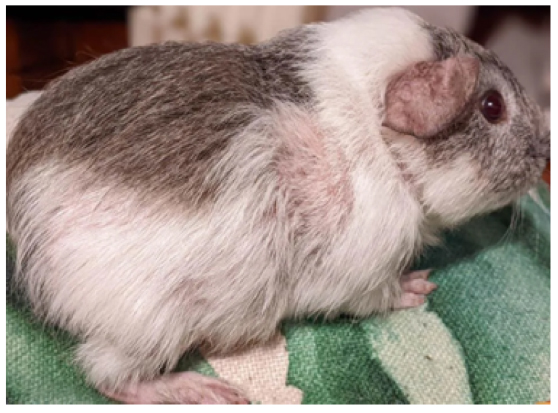
You can also offer “Oxbow Vitamin C Supplement” or “Sherwood Vitamin C Supplement“.
It is not recommended to supplement vitamin C through water. Vitamin C degrades very quickly when exposed to light and after 8hrs it is estimated that the amount of active vitmain C in the water is only 20% of the original amount added. So while the supplemented water bottle may have the correct dose in the morning, later in the day the vitamin C will have degraded. Some guinea pigs also don’t like the smell and taste of supplemented water so they may drink less and become dehydrated. This can cause further health problems like UTI’s.

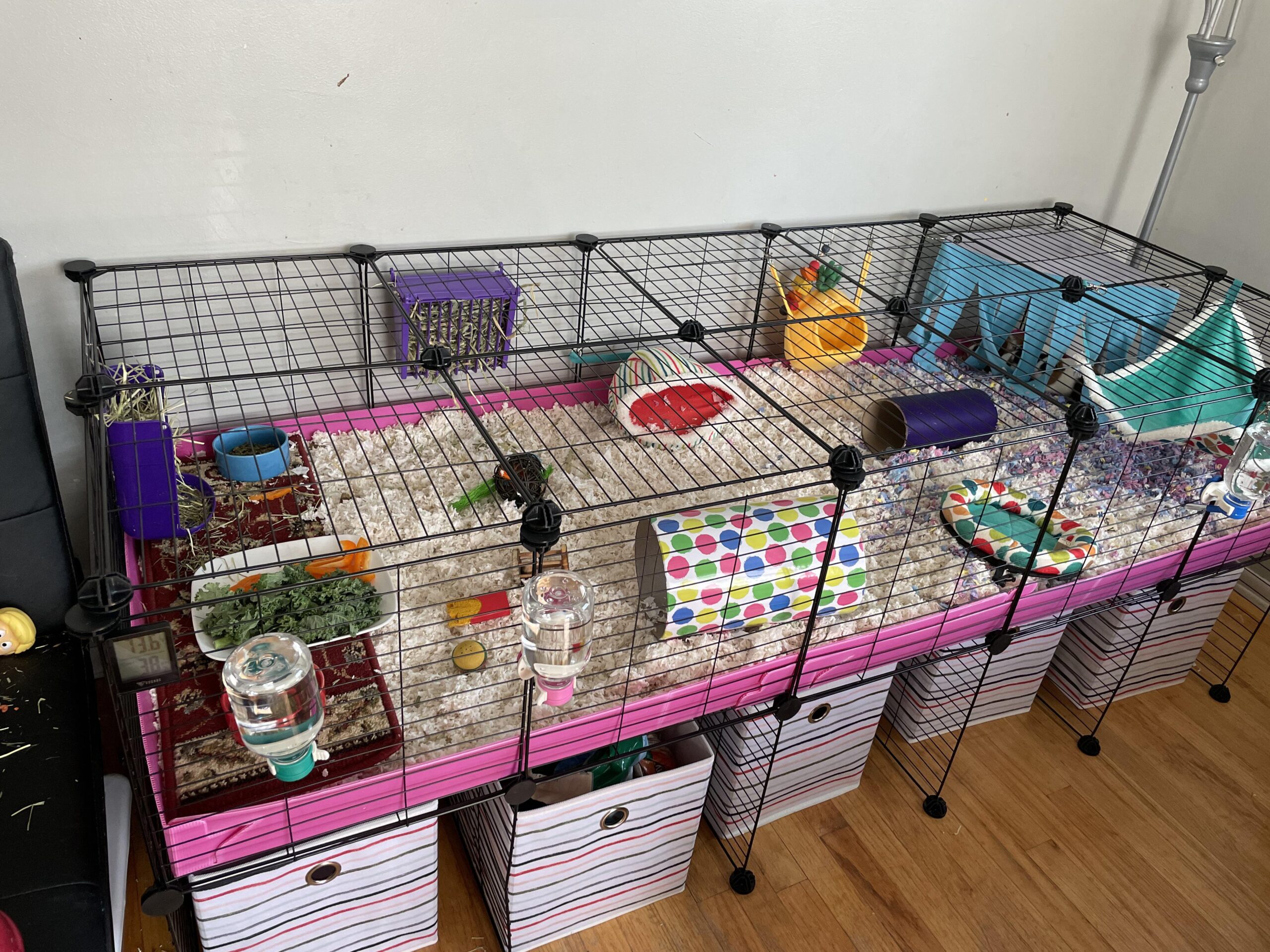
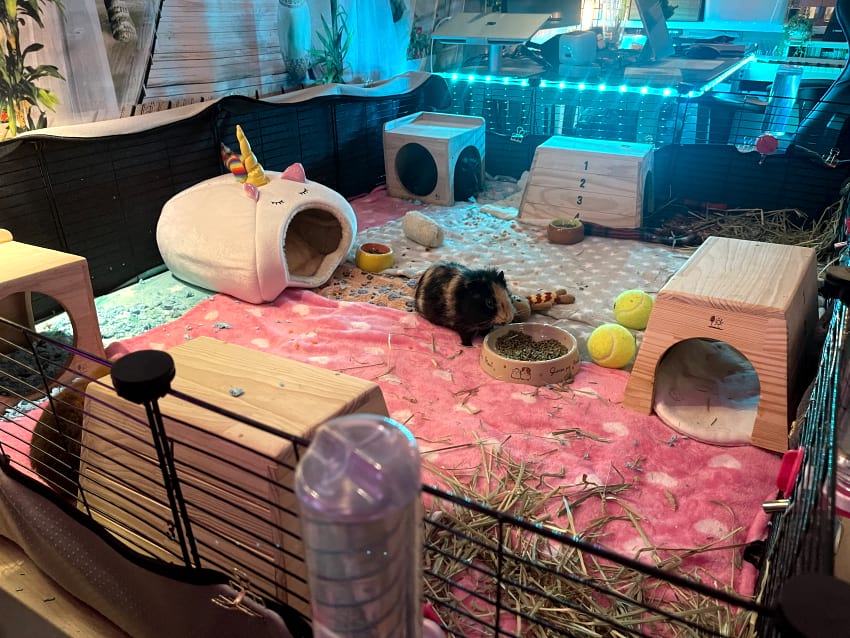
 Short-haired breeds like the American and Abyssinian have a smooth, short coat. These breeds are popular due to their friendly nature and ease of care in terms of grooming.
Short-haired breeds like the American and Abyssinian have a smooth, short coat. These breeds are popular due to their friendly nature and ease of care in terms of grooming. Long-haired breeds, like the Peruvian and Silkie, require more dedicated grooming. Their long, flowing hair will need to be brushed out daily or they can develop painful mats. They will also need to get their hair trimmed every 3-4 months, either at home or with an experiences groomer.
Long-haired breeds, like the Peruvian and Silkie, require more dedicated grooming. Their long, flowing hair will need to be brushed out daily or they can develop painful mats. They will also need to get their hair trimmed every 3-4 months, either at home or with an experiences groomer.
